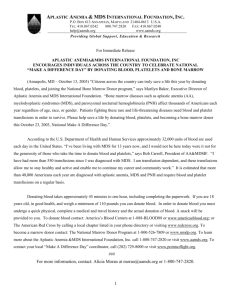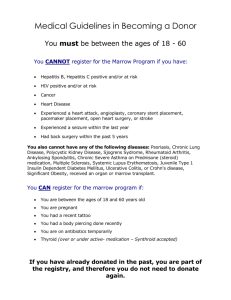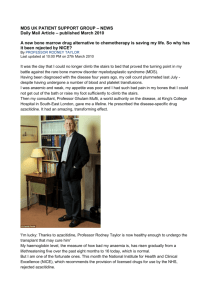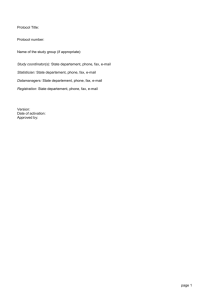1-15-07 Aplastic Anemia & Myelodysplastic Syndromes
advertisement
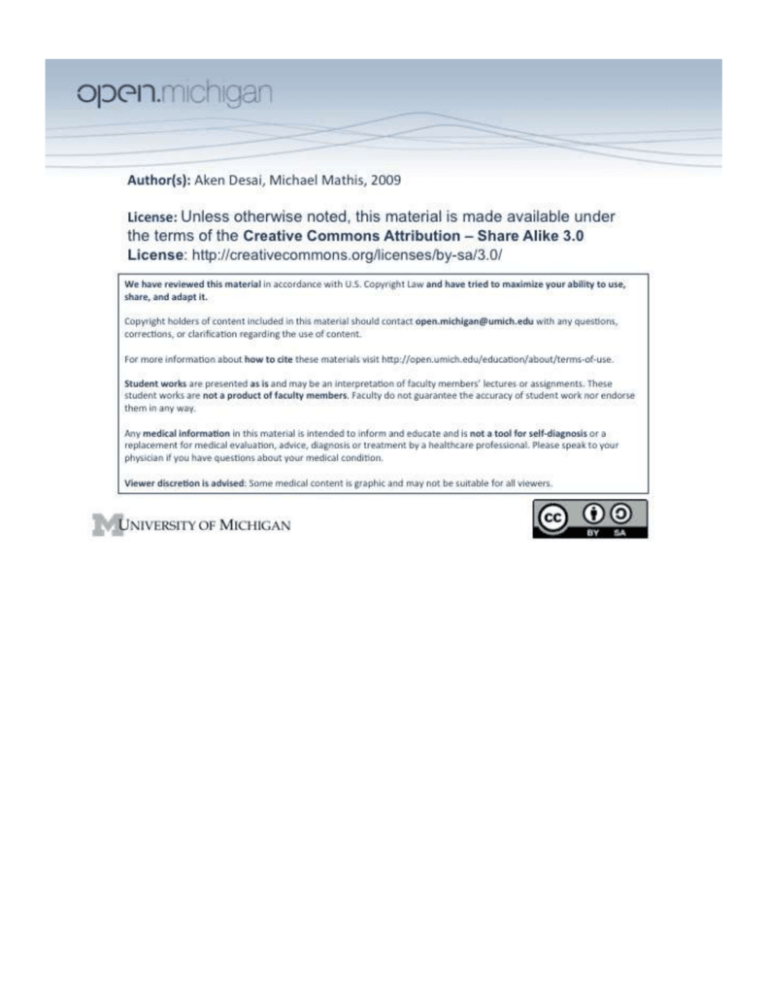
Aplastic Anemia & Myelodysplastic Syndromes Aplastic Anemia Aplastic Anemia – a pancytopenia with bone marrow hypocellularity (<25% cellular) o Severe AA – very low cell counts, usually indicate a non-spontaneous regression of disease o Bone marrow – required for Dx of AA Pancytopenia etiology – not just AA! Also MDS, neoplasm, toxins, nutritional, genetic, infection, HSM AA Classification – include idiopathic, secondary, & inherited o Idiopathic AA – aplastic anemia is primary disease o Secondary AA – AA 2o to radiation, chemotherapy, toxins (benzene), drugs, infection o Inherited AA – such as Fanconi’s anemia Diagnosis – blood counts, reticulocyte count, bone marrow biopsy shows loss of cellularity, work-up to rule out other causes Grading o Non-Severe – marrows cellularity <30%, absence of severe pancytopenia, depression of at least 2 blood elements o Severe – marrow cellularity < 25% or <50% w/ fewer than 30% hematopoietic cells and 2 of the following: ANC < 0.5 X 10^9, platelets < 20 X 10^9, retic count < 40 X 10^9 o Very Severe – as above but ANC < 0.2 X 10^9 Pathophysiology – damage/destruction/suppression of HSC depletion of stem cell pool bone marrow failure AA o Direct insult – toxicity of hematopoietic stem cell (HSC) to radiation, chemotherapy, benzene o Immune-mediated injury – T cells inhibit HSC colony formation; cytotoxins released in marrow Treatment – either matched sibling donor transplant (<20, 20-45 if healthy) or immunosuppression (otherwise): o Non-idiopathic – treat underlying condition o Supportive care Tranfusions – may become refractory, or if multiple needed may need iron chelation Antibiotics – to prevent neutropenic infection Growth factor support – GCSF, EPO Androgens – can stimulate hematopoiesis o Transplant – allogenic HSC transplantation; cyclophosphamide + ATG immunosuppress, prophylax for GVHD with MTX/cyclosporine; 88% 4-yr survival; complications are graft failiure, GVHD, secondary malignancy o Immunosuppression – give anti-thymocyte (T-cell) Ig’s + cyclosporine; stop T-cell inhibition 70% response; may take 3-4 months to see response, relapse is common but can respond to re-treatment; complications of serum sickness, renal failure (cyclosporine), HTN, late malignancies (MDS/AML) Myelodysplastic Syndrome MDS – acquired bone marrow failure syndromes, due to production of dysfunctional dysplastic clonal blood cells Heterogenous – MDS has many varying subtypes with many varying prognoses Bone marrow – usually hypercellular, but producing dysfunctional blood cells Dx – made through a morphological review of blood & marrow smears o Dyserythropoiesis – RBC anisopoikilocytosis, megaloblastic maturation and dysmorphic nuclei o Dysgranulopoiesis – Pelger-Huet cells (2 lobed nuclei vs. 5/6 nl) and hypogranularity o Dysplastic platelets – huge platelets o Dysmegakaryopoiesis – multiple separate nuceli and unilobulate megakaryocytes Presentation – cytopenia Sx (anemia symptoms, neutropenic infections, thrombocytopenic hemorrhage) Cytogenetics – involves DNA changes acquired in bone marrow only; rarely inherited o Abnormalities – various chromosomal abnormalities can be important for prognosis/Tx o Deletion 5q Syndrome – F predominance, 68 yo median, macrocytic anemia, nl-high platelets, erythroid hyperplasia, hypolobulated megakaryocytes, blasts < 20%, good prognosis, if no other mutations o Complex karyotypes – more than 3 abnormalities poor prognosis Prevalence – most common in elderly men Classification – includes FAB and IPSS: o French-American-British – classify by amount of blasts in blood/marrow (more = worse) o International Prognostic Scoring System – risk scores by blasts and karyotyping & cytopenias o WHO Classification – newest classification system… Blast percentage – less blasts longer survival and decreased conversion to leukemia Age – older had lower survival rates even in low-risk IPSS classes Treatment-Related MDS Chemotherapy – treatment for some marrow diseases, but has negative outcomes: o Alkylating agents – include cyclophosphamide, can put patient at risk for MDS & AML o Radiation exposure o MDS Recurrence – can occur 4-5 years after treatment, has poor prognosis o Genetics – deletion or loss of chromosome 5 and/or 7 and complex karyotypes are common; poor prognosis MDS Treatment Stem Cell Transplant – bone marrow transplant can help cure disease, more successful in young patients o Eligibility – young, no existing co-morbidities, available donor o Early low-risk MDS – delay transplant until disease progresses (still have good QOL now) o Later high-risk MDS – proceed to transplant ASAP Erythropoietin Therapy – give EPO to low/int-1 risk pts that are tranfusion dependent o Refractory – give ESA + GCSF Immunosuppressive – clonal amplification of T cells suppresses hematopoiesis so give ATG +/- cyclosporine Epigenetic Therapy Epigenetics – idea that genes can be turned off without destroying them o Promoter methylation – promoter region of genes can by methylated “off” by cytosine residues o Methyltransferase – methylates promoter region o Drug inhibition – azacitidine/decitabine can inhibit methyltransferase turn on genes again Azacitidine – methyltransferase inhibitor, leads to better blood counts & survival and decreased progression to AML in patients with MDS Decitabine – same deal as azacitidine… Lenalidomide – oral drug, stops MDS clone, sensitizes cells to EPO, decreases apoptotic cytokines o Inhibits MDS clone – will slow down MDS clone replication, also signal T-cell attack of clone o Promotes better growth – sensitizes cells to EPO (more RBCs), decreases apoptosis o Deletion 5q Syndrome – showed immensely positive response to lenalidomide Treatment Summary Calculate IPPS and cytogenetic analysis Trial of ESA if anemic Low/int-1 risk dz and del(5q), lenalidomide trial Azacitidine or decitabine for symptomatic MDS Allogeneic stem cell transplant for high-risk, young, healthy and available donor patients

